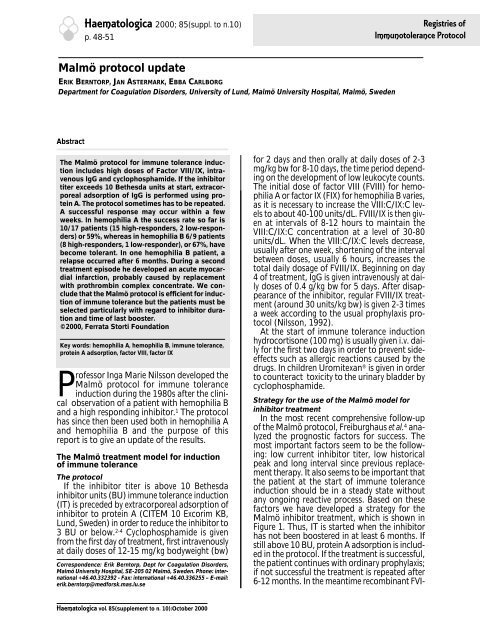Haematologica 2000;85:supplement to no. 10 - Supplements ...
Haematologica 2000;85:supplement to no. 10 - Supplements ...
Haematologica 2000;85:supplement to no. 10 - Supplements ...
Create successful ePaper yourself
Turn your PDF publications into a flip-book with our unique Google optimized e-Paper software.
<strong>Haema<strong>to</strong>logica</strong> <strong>2000</strong>; <strong>85</strong>(suppl. <strong>to</strong> n.<strong>10</strong>)<br />
p. 48-51<br />
Registries of<br />
Immu<strong>no</strong><strong>to</strong>lerance Pro<strong>to</strong>col<br />
Malmö pro<strong>to</strong>col update<br />
ERIK BERNTORP, JAN ASTERMARK, EBBA CARLBORG<br />
Department for Coagulation Disorders, University of Lund, Malmö University Hospital, Malmö, Sweden<br />
Abstract<br />
The Malmö pro<strong>to</strong>col for immune <strong>to</strong>lerance induction<br />
includes high doses of Fac<strong>to</strong>r VIII/IX, intrave<strong>no</strong>us<br />
IgG and cyclophosphamide. If the inhibi<strong>to</strong>r<br />
titer exceeds <strong>10</strong> Bethesda units at start, extracorporeal<br />
adsorption of IgG is performed using protein<br />
A. The pro<strong>to</strong>col sometimes has <strong>to</strong> be repeated.<br />
A successful response may occur within a few<br />
weeks. In hemophilia A the success rate so far is<br />
<strong>10</strong>/17 patients (15 high-responders, 2 low-responders)<br />
or 59%, whereas in hemophilia B 6/9 patients<br />
(8 high-responders, 1 low-responder), or 67%, have<br />
become <strong>to</strong>lerant. In one hemophilia B patient, a<br />
relapse occurred after 6 months. During a second<br />
treatment episode he developed an acute myocardial<br />
infarction, probably caused by replacement<br />
with prothrombin complex concentrate. We conclude<br />
that the Malmö pro<strong>to</strong>col is efficient for induction<br />
of immune <strong>to</strong>lerance but the patients must be<br />
selected particularly with regard <strong>to</strong> inhibi<strong>to</strong>r duration<br />
and time of last booster.<br />
©<strong>2000</strong>, Ferrata S<strong>to</strong>rti Foundation<br />
Key words: hemophilia A, hemophilia B, immune <strong>to</strong>lerance,<br />
protein A adsorption, fac<strong>to</strong>r VIII, fac<strong>to</strong>r IX<br />
Professor Inga Marie Nilsson developed the<br />
Malmö pro<strong>to</strong>col for immune <strong>to</strong>lerance<br />
induction during the 1980s after the clinical<br />
observation of a patient with hemophilia B<br />
and a high responding inhibi<strong>to</strong>r. 1 The pro<strong>to</strong>col<br />
has since then been used both in hemophilia A<br />
and hemophilia B and the purpose of this<br />
report is <strong>to</strong> give an update of the results.<br />
The Malmö treatment model for induction<br />
of immune <strong>to</strong>lerance<br />
The pro<strong>to</strong>col<br />
If the inhibi<strong>to</strong>r titer is above <strong>10</strong> Bethesda<br />
inhibi<strong>to</strong>r units (BU) immune <strong>to</strong>lerance induction<br />
(IT) is preceded by extracorporeal adsorption of<br />
inhibi<strong>to</strong>r <strong>to</strong> protein A (CITEM <strong>10</strong> Excorim KB,<br />
Lund, Sweden) in order <strong>to</strong> reduce the inhibi<strong>to</strong>r <strong>to</strong><br />
3 BU or below. 2-4 Cyclophosphamide is given<br />
from the first day of treatment, first intrave<strong>no</strong>usly<br />
at daily doses of 12-15 mg/kg bodyweight (bw)<br />
Correspondence: Erik Bern<strong>to</strong>rp, Dept for Coagulation Disorders,<br />
Malmö University Hospital, SE-205 02 Malmö, Sweden. Phone: international<br />
+46.40.332392 - Fax: international +46.40.336255 – E-mail:<br />
erik.bern<strong>to</strong>rp@medforsk.mas.lu.se<br />
for 2 days and then orally at daily doses of 2-3<br />
mg/kg bw for 8-<strong>10</strong> days, the time period depending<br />
on the development of low leukocyte counts.<br />
The initial dose of fac<strong>to</strong>r VIII (FVIII) for hemophilia<br />
A or fac<strong>to</strong>r IX (FIX) for hemophilia B varies,<br />
as it is necessary <strong>to</strong> increase the VIII:C/IX:C levels<br />
<strong>to</strong> about 40-<strong>10</strong>0 units/dL. FVIII/IX is then given<br />
at intervals of 8-12 hours <strong>to</strong> maintain the<br />
VIII:C/IX:C concentration at a level of 30-80<br />
units/dL. When the VIII:C/IX:C levels decrease,<br />
usually after one week, shortening of the interval<br />
between doses, usually 6 hours, increases the<br />
<strong>to</strong>tal daily dosage of FVIII/IX. Beginning on day<br />
4 of treatment, IgG is given intrave<strong>no</strong>usly at daily<br />
doses of 0.4 g/kg bw for 5 days. After disappearance<br />
of the inhibi<strong>to</strong>r, regular FVIII/IX treatment<br />
(around 30 units/kg bw) is given 2-3 times<br />
a week according <strong>to</strong> the usual prophylaxis pro<strong>to</strong>col<br />
(Nilsson, 1992).<br />
At the start of immune <strong>to</strong>lerance induction<br />
hydrocortisone (<strong>10</strong>0 mg) is usually given i.v. daily<br />
for the first two days in order <strong>to</strong> prevent sideeffects<br />
such as allergic reactions caused by the<br />
drugs. In children Uromitexan ® is given in order<br />
<strong>to</strong> counteract <strong>to</strong>xicity <strong>to</strong> the urinary bladder by<br />
cyclophosphamide.<br />
Strategy for the use of the Malmö model for<br />
inhibi<strong>to</strong>r treatment<br />
In the most recent comprehensive follow-up<br />
of the Malmö pro<strong>to</strong>col, Freiburghaus et al. 4 analyzed<br />
the prog<strong>no</strong>stic fac<strong>to</strong>rs for success. The<br />
most important fac<strong>to</strong>rs seem <strong>to</strong> be the following:<br />
low current inhibi<strong>to</strong>r titer, low his<strong>to</strong>rical<br />
peak and long interval since previous replacement<br />
therapy. It also seems <strong>to</strong> be important that<br />
the patient at the start of immune <strong>to</strong>lerance<br />
induction should be in a steady state without<br />
any ongoing reactive process. Based on these<br />
fac<strong>to</strong>rs we have developed a strategy for the<br />
Malmö inhibi<strong>to</strong>r treatment, which is shown in<br />
Figure 1. Thus, IT is started when the inhibi<strong>to</strong>r<br />
has <strong>no</strong>t been boostered in at least 6 months. If<br />
still above <strong>10</strong> BU, protein A adsorption is included<br />
in the pro<strong>to</strong>col. If the treatment is successful,<br />
the patient continues with ordinary prophylaxis;<br />
if <strong>no</strong>t successful the treatment is repeated after<br />
6-12 months. In the meantime recombinant FVI-<br />
<strong>Haema<strong>to</strong>logica</strong> vol. <strong>85</strong>(<strong>supplement</strong> <strong>to</strong> n. <strong>10</strong>):Oc<strong>to</strong>ber <strong>2000</strong>
















